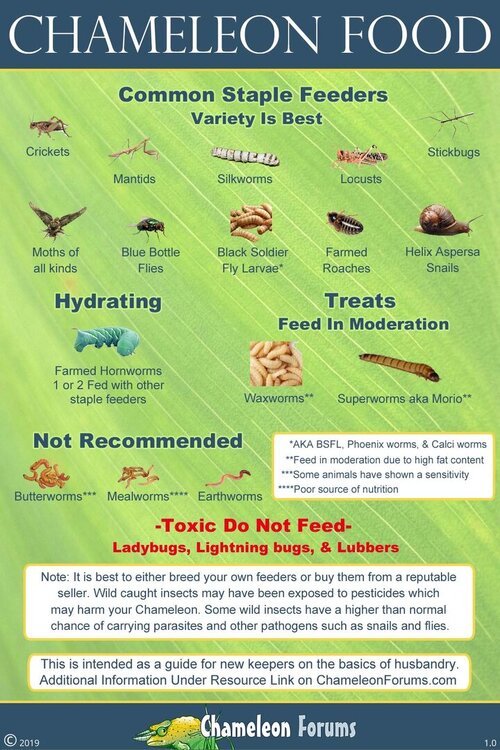elizaann2
Chameleon Enthusiast
Hello! See my response below in bold:
Chameleon Info:
Chameleon Info:
- Your Chameleon - The species, sex, and age of your chameleon. How long has it been in your care? Male jackson chameleon, about 3 years old, was in our care for 2 years after rescued from previous owner.
- Handling - How often do you handle your chameleon? We were needing to handle him daily to give him iodine soaks or injections. Before he got sick, we handles him maybe once every 2 weeks. Completely understand the daily handling due to him needing medications. However, just regular handling I would advise against. Chameleons are shy lizards and consistant handling can be quite stressful. With Jackson's I have noticed they are actually fairly passive and either just hold still and dont move or they just turn slightly darker colors when stressed by handling. My other chameleon's dont have a problem getting all bright, puffing out their gular and if necessary gaping at me to tell me they don't want me to handle them. I have learned to pay very close attention to my Jackson's subtle body language and back off if any handling or anything is stressing him. I don't typically recommend handling any chameleon unless you are doing a body check on them to ensure they are healthy and to remove them from their enclosure for a vet visit or an enclosure deep clean.
- Feeding - What are you feeding your cham? What amount? What is the schedule? How are you gut-loading your feeders? He barely ate at the end but we fed him solely crickets and dipped them in calcium powder every few crickets. When he was healthy he was eating 3-5 a day once a day as we fed him with long tweezer tongs or placed the crickets on a leaf near him. We recently had bought him a feeder (magnetic and the crickets crawl on the mesh cage). He would eat from that but was sick starting before we started using that. He wouldn’t eat any mealworms or anything else. You will want to feed a variety of bugs to your chameleon (document attached), different bugs have different nutritional values and you can imagine it would be boring to eat the same thing every single day
. For an adult chameleon you should be feeding them every other day 3-5 feeders. My schedule is below so if you want to use that for your next little guy or gal you can:
- Monday - Crickets
- Wednesday -BSFL
- Friday - Silkworms
- Saturday - Treat bug day (either wax worms or super worms)
- You will also want to gut load your bugs so they are healthy for your chameleon. This can be as simple as feeding appropriate fresh fruits and veggies to them. (attached document for you)
- Supplements - What brand and type of calcium and vitamin products are you dusting your feeders with and what is the schedule? Calcium powder, not sure exactly the brand but I remember it had a chameleon pictures on it. Usually every few days fed a calcium dusted cricket. If you still have the bottle I would love for you to share a pic so I can check it out. Not all supplements are great to use for our chameleons. You'll need a plain calcium for every feeding and then something that is a multivitamin with preformed vitamin A and a vitamin D3 supplement. This is what I use for my Jacksons:
- Every feeding - ReptiCal WITHOUT vitamin D3
- 1st of the month - Repashy LoD (this is a multivitamin and D3 all in 1)
- Watering - What kind of watering technique do you use? How often and how long to you mist? Do you see your chameleon drinking? We used to squeeze a spray bottle to let out a steady drip of water drops and he would drunk daily that way. Then we used a big dipper and he would occasionally drink from that as well. Before his infections we misted twice a day. We stopped misting all together the last 3 months per the direction of our vet. How did he get his hydration then if you weren't misting? Just the dripper? Chameleons are generally quite shy drinkers. Ideally for your next baby you'll have him/her hydrated enough that you do not see them drink. Depending on the temps you can achieve at night, a fog machine might be a good option for you as well. You will at least want to mist for 1-2 minutes each morning before lights come on, that way when your cham wakes up it can drink the droplets off the leaves, then install a dripper in the after noon, if you see him/he rush to drink you know you need to adjust something in your hydration strategy so you don't see this behavior. Mist again for 1-2 minutes after lights turn off. IF you can achieve temps below 68 degrees at night then a fog machine is excellent, have that go off in 30 minute sessions between 12-6 am and make adjustments where necessary.
- Fecal Description - Briefly note colors and consistency from recent droppings. Has this chameleon ever been tested for parasites? He was never tested but usually brown or white poop. One time he had orange poop from what I saw on a leaf when we went to clean it out. We typically monitor our chameleon's hydration from their poop, you want their poops to be firm but moist and the urates (chameleon pee) to be white. Orange means they are dehydrated. I strongly recommend getting your chameleon tested for parasites when you first get them and then at least once a year to ensure they do not have any parasites.
- History - Any previous information about your cham that might be useful to others when trying to help you. He used to be extremely malnourished when we got him and completely dark brown. He also did not shed once he got sick. Poor guy, it sounds like you did a good job taking care of him then, thank you for taking care of that little guy






